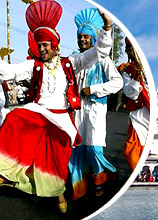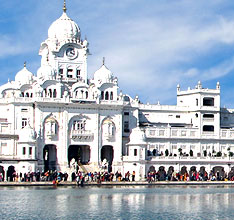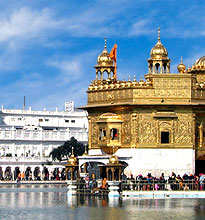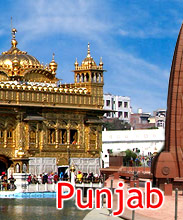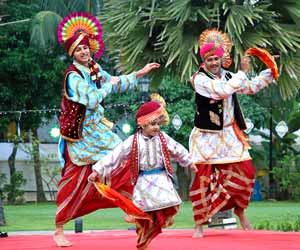 Bhangra is the most popular folk dance of Punjab. It represents the liveliness and dynamism of its people. The dance mainly involves men, who perform to the fast beats of drum and music. Originally performed on the Baisakhi festival, the harvest festival of Punjab, bhangra is done at every single festive occasion today. In fact, Punjabis dance to the beats of drum and perform the bhangra in every celebration. The folk dance has even spread beyond the frontiers of Punjab, to places across the globe. Every party, occasion or gathering is sure to have a bhangra performance. Some of the well-known Bhangra artists of Punjab are Surinder Shinda, Harbhajan Mann, Manmohan Waris, Meshi Eshara, Hans Raj Hans, Sardool Sikander, and Sahotas.
Bhangra is the most popular folk dance of Punjab. It represents the liveliness and dynamism of its people. The dance mainly involves men, who perform to the fast beats of drum and music. Originally performed on the Baisakhi festival, the harvest festival of Punjab, bhangra is done at every single festive occasion today. In fact, Punjabis dance to the beats of drum and perform the bhangra in every celebration. The folk dance has even spread beyond the frontiers of Punjab, to places across the globe. Every party, occasion or gathering is sure to have a bhangra performance. Some of the well-known Bhangra artists of Punjab are Surinder Shinda, Harbhajan Mann, Manmohan Waris, Meshi Eshara, Hans Raj Hans, Sardool Sikander, and Sahotas.History
Bhangra originated as a dance form during the Indo-Scythian period of Punjab, from 2000 BC. Traditionally, the dance was a fusion of music, song, beats of the dhol (drum), and music from a single-stringed instrument called the iktar (ektara), the tumbi and the chimta. Today, another instrument, called dholki is also used to provide the beats for bhangra. Some other popularly used instruments are dhad, dafli, dholki and damru. The songs are sung in the form of couplets called the bolis.
Music
Social issues form the major theme of the bhangra songs. Love, relationship, money, marriage etc provide the base for the lyrics. In addition, the brave deeds of the great heroes of the state find narration in a song meant for bhangra. In particular, many bhangra tracks are written about Udham Singh and Bhagat Singh. Bhangra singers sing in a highly energetic tone, frequently adding the phrases like hoi hoi hoi, balle balle, oye hoi, or haripa to the music.
Outfits
Traditionalbhangra costume consists of a kurta that is similar to a silk-buttoned shirt, has embroided patterns and is loose to wear. It is combined with lungi - a cloth tied around the dancers’ waist that is usually decorated and jugi - a waistcoat with no buttons. The dancers wear a turban (pugdee or patka) with torla - a fan like structure and carry a rummal - essentially, colorful scarves tied on to the fingers. The rummal look very effective when the hands move, during the course of the performance. Some dancers also wear small rings (nuntian) in their ears.
Movements
Bhangra is performed with a number of male dancers, who move around the drummer in a circle. The drummer, now and then, lifts the two sticks with which he beats the drum, to beckon the dancers to a higher tempo of movement. They start with a slow movement of their feet. As the tempo increases, first the hands and feet and then the whole body comes into action. They whirl round and round, bending and straightening their bodies alternatively, hopping on one leg, raising their hands, clapping with their hands and exclaiming Bale Bale! Oh Bale Bale! At intervals, the dancers stop moving, but continue to move to the rhythm with their feet. One of the dancers comes near the drummer and covering his left ear with his palm, sings a boali or dholla, derived from the traditional folk songs of Punjab. Picking up the last lines, the dancers again start dancing with greater vigor.

